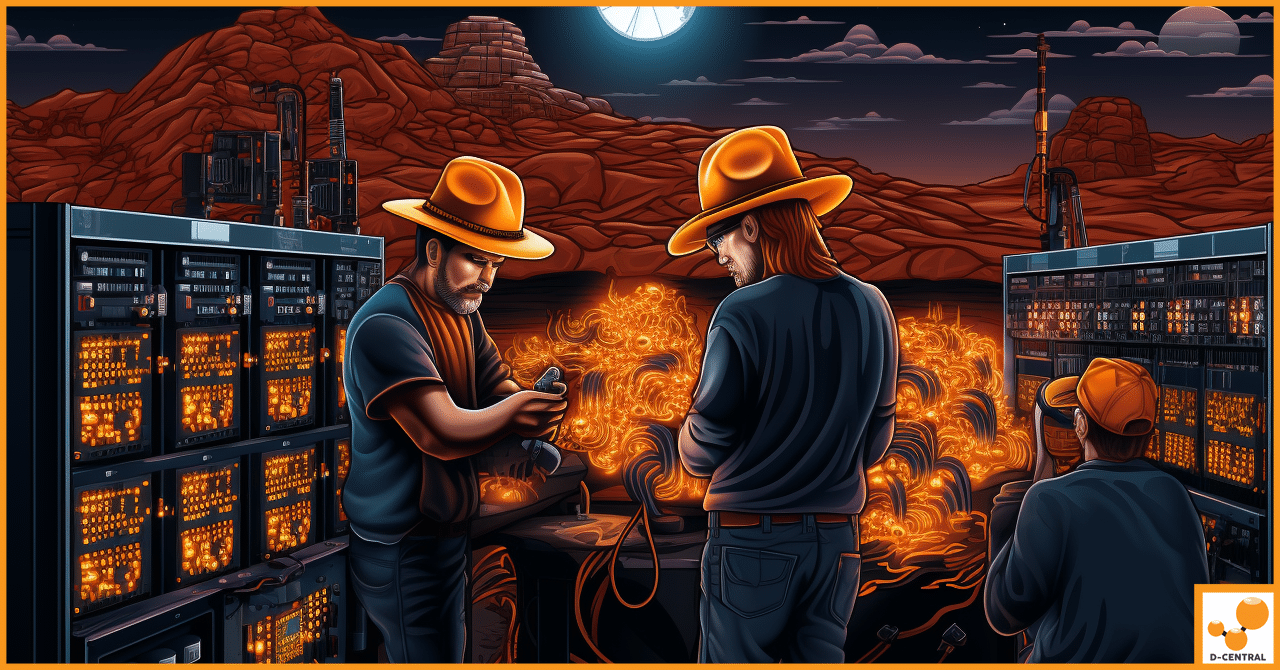
ASIC Repair: Dos and Don’ts Every Miner Should Know
In the rapidly evolving world of cryptocurrency, Application-Specific Integrated Circuit (ASIC) miners have become the backbone of the industry. These
4479 Desserte Nord Autoroute 440, Laval, QC H7P 6E2

Bitcoin mining stands as a cornerstone that not only facilitates the creation of new bitcoins but also secures the entire network. By solving a repetitive set of mathematical problems, miners validate transactions and add them to the blockchain, thereby maintaining the integrity and functionality of the decentralized Bitcoin network.
But what if this computational power could serve a dual purpose? Enter the Electric Reliability Council of Texas (ERCOT), the governing body that oversees the electricity grid and manages the deregulated market for 90% of Texas. ERCOT plays a critical role in ensuring that electricity is distributed efficiently, reliably, and at a reasonable cost.
One of the lesser-known but vital aspects of ERCOT’s operations is the provision of Ancillary Services—additional services beyond basic electricity supply that help maintain grid stability and reliability. These services are essential for balancing supply and demand, ensuring quality power, and providing backup during emergencies.
This brings us to a compelling question that could redefine the dynamics of Bitcoin mining and energy markets: Can Bitcoin miners participate in ERCOT’s Ancillary Services to earn additional income and save on electricity costs?
In the context of ERCOT’s operations, a Load Resource (LR) is a type of resource that can provide Ancillary Services by modulating its electricity consumption in response to grid conditions. Essentially, an LR is any load connected to the ERCOT grid that has a meter capable of measuring its consumption and response. By participating in the Ancillary Services market, LRs can submit bids to ERCOT, specifying the amount of load reduction or increase they can offer, the price they’re willing to accept, and the type of service they can provide. If ERCOT accepts the bid, the LR is then obligated to respond to ERCOT’s signals and instructions, receiving payments for its performance.
A Controllable Load Resource (CLR) is a type of LR that can respond to ERCOT’s signals within 10 minutes and sustain its response for at least 15 minutes. CLRs can provide services like Responsive Reserve Service (RRS) and Emergency Response Service (ERS), which are fast-acting services that help maintain the frequency and voltage of the grid.
On the other hand, a Non-Controllable Load Resource (NCLR) is a type of LR that can respond to ERCOT’s signals within 30 minutes and sustain its response for at least 30 minutes. NCLRs can provide Non-Spinning Reserve Service (NSRS), a service that helps replace RRS when it is depleted.
For Bitcoin miners, becoming an LR in ERCOT’s Ancillary Services market presents an attractive financial opportunity. By reducing their electricity consumption when the grid is under stress and resuming normal operations when the grid is stable, Bitcoin miners can earn additional income. This is particularly enticing given the high electricity costs associated with Bitcoin mining.
By understanding the role and types of Load Resources within ERCOT and the financial incentives for Bitcoin miners, we can better appreciate the synergistic possibilities that exist at the intersection of cryptocurrency and energy markets.
Non-Spinning Reserve Service (NSRS) is an Ancillary Service that provides additional generation or load reduction to the grid within 30 minutes of a dispatch instruction from ERCOT. NSRS is used to replace or supplement Responsive Reserve Service (RRS) when it is depleted.
Bitcoin miners, particularly those classified as Non-Controllable Load Resources (NCLRs), can participate in NSRS by reducing their electricity consumption within 30 minutes of receiving a dispatch instruction from ERCOT. By doing so, they can earn additional income while also reducing their electricity costs.
Responsive Reserve Service (RRS) is an Ancillary Service that provides fast-acting generation or load reduction to the grid within 10 minutes of a dispatch instruction. RRS is crucial for maintaining grid frequency and voltage.
Bitcoin miners that are classified as Controllable Load Resources (CLRs) can participate in RRS. By modulating their electricity consumption within 10 minutes of receiving a dispatch instruction, they can provide fast-acting load reduction, earning payments for their service.
Emergency Response Service (ERS) is an Ancillary Service designed for situations where there is an immediate need for electricity supply or demand reduction to maintain grid stability. ERS is typically activated during peak demand periods or emergencies.
Bitcoin miners, both as CLRs and NCLRs, can participate in ERS by agreeing to reduce their electricity consumption during peak demand periods or emergencies. This allows them to earn higher payments compared to other Ancillary Services due to the urgent nature of ERS.
The 4 Coincident Peak (4CP) program is not an Ancillary Service but is a demand response program in Texas. It identifies the four 15-minute intervals during the summer months when electricity demand is at its highest. ERCOT uses these intervals to determine transmission charges for the following year.
By participating in the 4CP program, Bitcoin miners can significantly reduce their transmission charges for the next year. This is achieved by reducing their electricity consumption during the 4CP intervals, thereby lowering their contribution to the peak demand. This can result in substantial cost savings, making it another financial incentive for Bitcoin miners to integrate their operations with ERCOT’s programs.
By understanding the types of Ancillary Services and other programs like 4CP, Bitcoin miners can identify multiple avenues for additional income and cost savings. These opportunities not only make mining operations more profitable but also contribute to grid stability, creating a win-win situation for both ERCOT and the Bitcoin mining community.
One of the most compelling benefits for Bitcoin miners participating in ERCOT’s Ancillary Services is the potential for additional income. By offering their mining operations as a load resource, miners can earn payments for their services, which can be a significant supplement to their mining rewards. Additionally, participating in these services can lead to electricity savings. For example, by reducing consumption during peak demand periods, miners can lower their electricity bills, making their operations more cost-effective.
To participate in Ancillary Services, Bitcoin miners need to have the technical capabilities to modulate their electricity consumption quickly and efficiently. This may require investment in advanced hardware and software solutions, which can be costly.
Reliability is another challenge. Miners must be able to respond to ERCOT’s dispatch instructions promptly and accurately. Failure to do so can result in penalties and may disqualify them from future participation.
While the financial incentives are attractive, they must outweigh the potential risks and costs involved. Miners need to consider the balance between the additional income from Ancillary Services and the investment required for the necessary technical upgrades.
“The balance between risk and reward in providing Ancillary Services is a crucial consideration for Bitcoin miners. While the potential for additional income and cost savings is significant, it comes with its own set of challenges that require careful planning and investment.”
Understanding both the benefits and challenges is essential for Bitcoin miners considering participation in ERCOT’s Ancillary Services. By weighing the potential rewards against the risks and costs involved, miners can make an informed decision that aligns with their operational goals and financial objectives.
ERCOT employs a complex set of methodologies to determine the minimum requirements for each type of Ancillary Service. These methodologies are designed to ensure that the Texas electricity grid remains stable, efficient, and capable of meeting the state’s energy demands. The requirements are calculated based on several factors, including but not limited to:
For NSRS, ERCOT considers the largest single contingency on the grid, such as the sudden loss of a large power plant, and calculates the reserve needed to cover that contingency.
RRS requirements are determined based on the grid’s frequency response characteristics. ERCOT evaluates how quickly and effectively the grid can respond to frequency deviations to ensure stability.
ERS requirements are based on extreme scenarios, such as multiple contingencies occurring simultaneously. ERCOT calculates the amount of reserve needed to handle such rare but impactful events.
4CP requirements are calculated based on the four highest system-wide peak demand intervals from the previous year. This helps ERCOT prepare for peak demand situations.
By understanding ERCOT’s methodologies for determining Ancillary Service requirements, Bitcoin miners can better assess their potential role and contributions in this market. This knowledge is crucial for making informed decisions about whether or not to participate in these services.
ERCOT employs a robust set of systems and processes to monitor and control Ancillary Services on the Texas electricity grid. These mechanisms are designed to ensure that the grid remains stable, reliable, and efficient, even as it faces varying levels of demand and supply. Below is an overview of how ERCOT manages these crucial services.
ERCOT uses advanced real-time monitoring systems that collect data from various points on the grid. These systems track key metrics such as:
The data is then analyzed to assess the grid’s current state and predict future conditions.
The Dispatch Control Center is the nerve center of ERCOT’s operations. Here, operators use the data from the monitoring systems to make real-time decisions about dispatching Ancillary Services. They can activate or deactivate services like Non-Spinning Reserve Service (NSRS), Responsive Reserve Service (RRS), and Emergency Response Service (ERS) as needed.
ERCOT also employs automated control algorithms that can make rapid adjustments to the grid. These algorithms are designed to respond to certain conditions without human intervention, ensuring a quicker response time.
ERCOT maintains secure and reliable communication protocols with all providers of Ancillary Services, including potential Bitcoin mining operations acting as Load Resources. This ensures that instructions for activation or deactivation of services are transmitted quickly and accurately.
To ensure that all providers meet the necessary standards, ERCOT conducts regular audits and compliance checks. These assessments verify that the providers have the technical capabilities to offer the services they are contracted for and that they are fulfilling their obligations effectively.
ERCOT uses feedback loops to continuously improve its monitoring and control systems. This involves analyzing performance data, identifying areas for improvement, and implementing changes to optimize the system.
By understanding ERCOT’s sophisticated systems and processes for monitoring and controlling Ancillary Services, Bitcoin miners can gain insights into how they can effectively participate in this market. This knowledge is invaluable for making informed decisions and optimizing the benefits of being a Load Resource in the ERCOT market.
As the energy landscape continues to evolve, so too will the demand for Ancillary Services and the role of Load Resources (LRs) within the ERCOT market. Below, we explore some of the key trends and future outlooks that Bitcoin miners and other stakeholders should be aware of.
With the growing integration of renewable energy sources like wind and solar, the need for Ancillary Services is expected to rise. These intermittent energy sources introduce variability into the grid, requiring more frequent adjustments to maintain stability. As a result, services like Non-Spinning Reserve Service (NSRS) and Responsive Reserve Service (RRS) will likely see increased demand.
As the financial incentives for becoming a Load Resource become more apparent, more entities, including Bitcoin miners, are expected to enter the market. This increased competition could drive innovation but may also lead to reduced margins for individual LRs. Therefore, it’s crucial for Bitcoin miners to continually assess the cost-benefit analysis of participating in ERCOT’s Ancillary Services.
Advancements in technology are set to play a significant role in shaping the future of Ancillary Services. For instance, the development of more efficient mining hardware could make it easier for Bitcoin miners to participate as LRs. Additionally, advancements in grid management software and automated control algorithms could make the provision of Ancillary Services more efficient and reliable.
Understanding the future trends and outlooks in the ERCOT market can help Bitcoin miners make informed decisions about their participation in Ancillary Services. As the market evolves, staying ahead of these trends will be crucial for maximizing benefits and mitigating risks.
Are you a Bitcoin miner interested in exploring the opportunities within the ERCOT market? While D-Central Technologies does not operate directly in Texas, we have a vast network of partners located there. What’s more, we offer our own Canadian version of services, under the D-Central umbrella and through our network of partner facilities in Quebec and Alberta!
By keeping an eye on these future trends and continually adapting, Bitcoin miners can not only contribute to a more stable and efficient energy grid but also find new avenues for revenue and cost savings.
Contact D-Central Technologies today for comprehensive mining support, consultation, and outsourcing solutions tailored to your needs, whether you’re in Texas, Quebec, Alberta, or anywhere else.
What is the role of Bitcoin miners in the ERCOT’s Ancillary Services?
Bitcoin miners can participate in ERCOT’s Ancillary Services to earn additional income and save on electricity costs by reducing their electricity consumption when the grid is under stress and resuming normal operations when the grid is stable.
What is a Load Resource (LR) in the context of ERCOT’s operations?
A Load Resource (LR) is a type of resource that can provide Ancillary Services by modulating its electricity consumption in response to grid conditions.
What Types of LRs exist within ERCOT?
There are two types of Load Resources within ERCOT: Controllable Load Resource (CLR) and Non-Controllable Load Resource (NCLR).
What is Non-Spinning Reserve Service (NSRS)?
Non-Spinning Reserve Service (NSRS) is an Ancillary Service that provides additional generation or load reduction to the grid within 30 minutes of a dispatch instruction from ERCOT.
How can Bitcoin miners participate in ERCOT’s programs?
Bitcoin miners can participate in ERCOT’s programs like Non-Spinning Reserve Service (NSRS), Responsive Reserve Service (RRS), Emergency Response Service (ERS) and the 4 Coincident Peak (4CP) program by modulating their electricity consumption in response to ERCOT’s instructions.
What are the benefits and challenges for Bitcoin miners participating in ERCOT’s Ancillary Services?
Benefits include additional income and electricity savings, while challenges involve the need for technical capabilities to promptly and accurately respond to ERCOT’s dispatch instructions and reliability.
How does ERCOT determine minimum Ancillary Service requirements?
ERCOT employs a complex set of methodologies to determine the minimum requirements for each type of Ancillary Service. These methodologies are designed to ensure that the Texas electricity grid remains stable and capable of meeting the state’s energy demands.
DISCLAIMER: D-Central Technologies and its associated content, including this blog, do not serve as financial advisors or official investment advisors. The insights and opinions shared here or by any guests featured in our content are provided purely for informational and educational purposes. Such communications should not be interpreted as financial, investment, legal, tax, or any form of specific advice. We are committed to advancing the knowledge and understanding of Bitcoin and its potential impact on society. However, we urge our community to proceed with caution and informed judgment in all related endeavors.
Related Posts

In the rapidly evolving world of cryptocurrency, Application-Specific Integrated Circuit (ASIC) miners have become the backbone of the industry. These

The Bitcoin mining industry has undergone a remarkable transformation since its inception. In the early days, mining was a frontier

In the ever-evolving landscape of finance and technology, Bitcoin emerges not merely as a digital asset but as a revolutionary